Traveling In Space With Jesus Christ: 8
It's not surprising, in our present culture of digital watches and wall calendars, that we've lost the original astronomical meaning of these Bible stories.
Today most people never look at the stars or pay any attention to the position of the sun in the sky.
The following is the result of intensive investigation into the Bible, its contents, origin, history, and everything that modern day biblical scholars know.
"Traveling In Space With Jesus Christ " Is a series of lessons that will show you the similarities between the story of Jesus Christ's journey, while being compared to the journey that our very own Sun takes through the constellations.
This is a continuation from the first lessons series of 39.
In order for you to understand the entire concept, it is of extreme importance that you read all of this in order starting with lesson one
Please DO NOT skip ahead. Doing so will just cause you confusion and eventually will end with you in cognitive dissonance.
Introduction

In ancient times people were very familiar with the Sun and the stars. At night they had nothing better to do than gaze up at the stars. They saw how the stars move across the sky during the night, and how different constellations are visible at different times of the year.
They made up stories which were allegories based on what they saw. Later on, these stories took on a life of their own, as the stories were passed down from generation to generation but the knowledge of what the stories represented was lost. People started believing the stories were real and actual history of events that actually really happened in the past, when originally the stories were nothing more than allegories for what people saw happening in the stars.
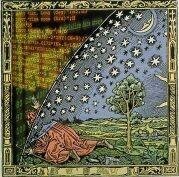
The ancients looked to the sky to determine what time of year it was. It was important to know what time of year it was. You needed to know when it was time to plant crops and when it was time to harvest the crops. As the year passed the Sun appears to make a journey through the constellations of the Zodiac. The entire story of Jesus’ ministry is an allegory for this journey.
Lesson 18: The Sun Enters Aquarius at "Age 30"
The constellations of the Zodiac are not all the same size, nor are they evenly spaced. Some of the constellations even overlap one another. It's somewhat arbitrary where to draw the line between one constellation and another. Part of this problem is alieviated by simply declaring that the divisions between the twelve constellations are evenly spaced.
The zodiac is divided into twelve equal areas, with each area containing one zodiac constellation. Each area is known as a "house". So when the sun is in the constellation Capricorn, it may be said, "the sun is in the house of Capricorn."
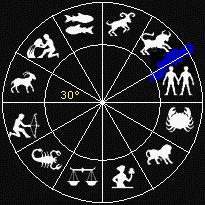
If we divide a circle into twelve equal parts, and place the twelve constellations of the zodiac in order around the circle, one in each part, we see that each constellation occupies 30 degrees of the circle.
 Dec. 22 - Jan. 19 Capricorn (the goat, in the wedge marked 30°)
Dec. 22 - Jan. 19 Capricorn (the goat, in the wedge marked 30°) Jan. 20 - Feb. 18 Aquarius (man pouring water from pitcher)
Jan. 20 - Feb. 18 Aquarius (man pouring water from pitcher) Feb. 19 - Mar. 20 Pisces (the two fish)
Feb. 19 - Mar. 20 Pisces (the two fish) Mar. 21 - Apr. 19 Aries (a sheep, ram, or lamb)
Mar. 21 - Apr. 19 Aries (a sheep, ram, or lamb) Apr. 20 - May 20 Taurus (the bull)
Apr. 20 - May 20 Taurus (the bull) (The Milky Way lies between Taurus and Gemini)
(The Milky Way lies between Taurus and Gemini) May 21 - June 20 Gemini (the twins Castor & Pollux see Acts 28:11)
May 21 - June 20 Gemini (the twins Castor & Pollux see Acts 28:11) June 21 - July 22 Cancer (the crab)
June 21 - July 22 Cancer (the crab) July 23 - Aug. 22 Leo (the lion)
July 23 - Aug. 22 Leo (the lion) Aug. 23 - Sept. 22 Virgo (the virgin, holding a sheaf of wheat, or an ear of corn, or a fruit)
Aug. 23 - Sept. 22 Virgo (the virgin, holding a sheaf of wheat, or an ear of corn, or a fruit) Sept. 23 - Oct. 22 Libra (the scales)
Sept. 23 - Oct. 22 Libra (the scales) Oct. 23 - Nov. 21 Scorpio (the scorpion)
Oct. 23 - Nov. 21 Scorpio (the scorpion) Nov. 22 Sagittarius (the archer or hunter, depicted as a centaur, half man half horse)
Nov. 22 Sagittarius (the archer or hunter, depicted as a centaur, half man half horse)
The tradition of having 360 degrees in a circle probably comes from it being a nice convenient number very near the number of days in a year. 360 is a nice round number that can be evenly divided into 2 parts, or 4 parts, or 10 parts, or 12 parts, or 36 parts, or 72 parts—whatever you feel like, whereas the actual solar year of 365.2421934 days is not as easy a number to deal with.
The sun travels about one degree each day. It's not exact, since there are actually 365.2421934 days in a solar year instead of 360. Also the earth's orbit isn't a perfect circle, it's slightly eliptical. The earth travels slightly faster during the winter months when it's slightly closer to the sun, and it travels slightly slower during the summer months when it's slightly farther from the sun. In general though, one degree equals about one day. (The seasons are primarily caused by the earth's tilt, not by it's varying distance from the sun.
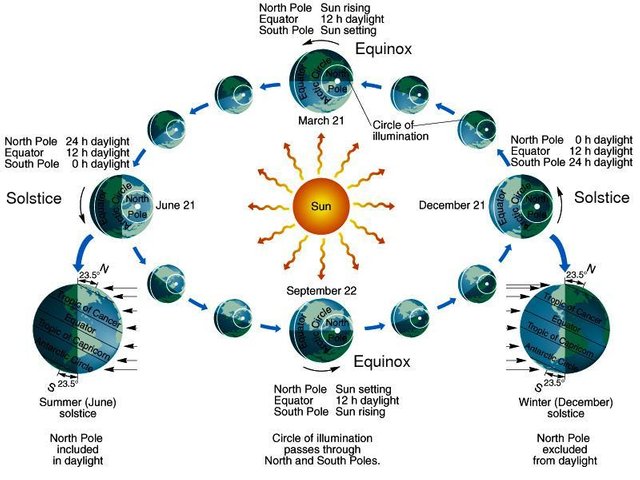
It's still ambiguous exactly when the sun leaves one house and enters another. The standard dates used by astrologers for the past two millenium (the ones given in the table above) correspond to a time somewhere in the range of around 600 B.C.E. to 1 C.E. Today, some 2000 years later, due to the Earth's precession the sun is in Sagittarius on Dec. 22, and you have to wait until around Jan. 18 before you can say the sun is in Capricorn. However, the tradition of having Capricorn cover the days from December 22 to January 19 still remains today. Have a look at any astrology or horoscope section of a newspaper (if your newspaper has such a section. No one today really believes in astrology, but some newspapers still have one just for the fun of it.)
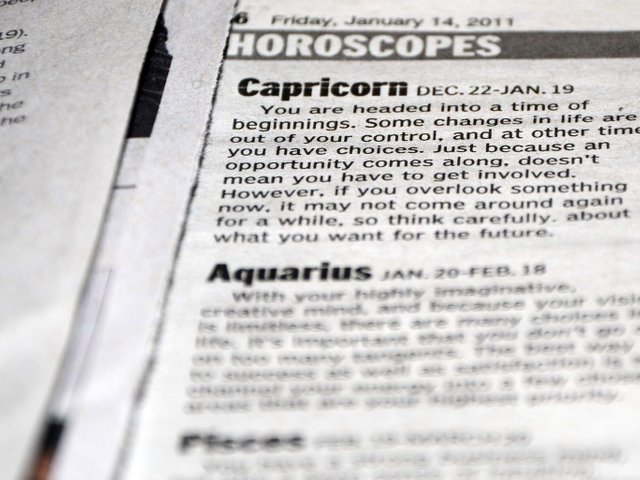
You'll see there listed the twelve constellations of the zodiac, covering the full year, with Capricorn beginning on December 22, the Winter Solstice. Though the winter solstice is a natural place to begin the year, you'll notice the astrology section always begins with Aries, March 21, which is the vernal equinox, another common place to begin the year.
For our purposes it doesn't matter exactly what day the sun leaves one house and enters the next. It's the overall story line we are concerned about. We want to know the general sequence of events that occurs during the solar year.
If we accept the old tradition of having the sun enter Capricorn on the Winter Solstice, a natural place to start the yearly cycle, then when the sun has traveled 30 degrees the sun exits Capricorn and enters Aquarius. Thus an allegorical story of the sun's annual travels could have the sun character visiting the Aquarius character at "Age 30" That's actually 30 degrees, or about 30 days, but an allegory could use 30 years instead.
- On the Winter Solstice the sun enters Capricorn. The Sun then passes through Capricorn, traveling 30 degrees in 30 days, to reach Aquarius at "age 30". Entering Aquarius is the first big event of the journey.
Jesus is said to have begun his ministry at age 30 (Luke 3:23). Jesus begins his ministry by visiting John the Baptist (Aquarius), who baptises with water.
- The Sun's annual journey around the zodiac takes one year.
Jesus' ministry is said to have lasted one year. [At least according to the Synoptic Gospels (Matthew, Mark, Luke). The Gospel of John implies Jesus' ministry lasted 3 years. The Gospel of John contradicts the Synoptic Gospels many times, which, by definition, is why it's not one of the "Synoptic" Gospels. Here we are concentrating on Jesus' mission as described in the Synoptic Gospels.]
Lesson 19: Outlining the Solar Myth - Aquarius
1 The Sun is born, or re-born, on December 25th.
*Jesus is born on December 25—Christmas Day.*
2 On the Winter Solstice the sun enters Capricorn. The Sun then passes through Capricorn, traveling 30 degrees in 30 days, to reach Aquarius at "age 30". Entering Aquarius is the first big event of the journey.
*Jesus begins his ministry at "about 30 years of age" by visiting John the Baptist, who baptizes with water.*
3 The Sun's annual journey through the twelve houses of the zodiac takes one year.
*Jesus' ministry is said to take one year (according to the Synoptic Gospels).*
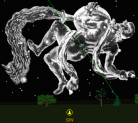
Aquarius is depicted by a man pouring out a pitcher of water. At left we have the illustration of what Aquarius is supposed to look like on the western horizon, if you have a very good imagination. It takes quite an imagination to see this in the stars. The idea of a man pouring out water has more to do with what is happening at that time of year. (See The constellations don't look like what they're named).
The Sun enters Aquarius around Jan. 20. January is the rainy season. There is a lot of water everywhere. In January the days start to get longer and longer, as the Sun climbs higher and higher in the sky each day. The days also begin to get warmer and warmer, because the angle of the Sun's rays changes. The longer warmer days cause any snow that has accumulated in the higher mountains to melt, adding to the inundation of water. Rivers rise and may flood. This is the first step in the harvest cycle. We look forward to the promise of a good harvest later on in the year.
- The Sun visits Aquarius who immerses the land with water.
Jesus starts his one year ministry by visiting John the Baptist who baptises with water (Matthew 3).
Lesson 20: Outlining the Solar Myth -
Theme of Temptation to be Lazy
Near the beginning of any long and difficult journey, such as the one the Sun has just embarked on, there is the temptation to be lazy. Why should the Sun embark on such a long and difficult journey? Why should the Sun bother to climb higher and higher in the sky each day, making the days longer and the dark nights shorter? We want the Sun to conquer the cold and darkness with longer warmer days. The Sun is tempted to be lazy. However, for our sake, the Sun will resist that temptation to give in to the forces of cold and darkess. The Sun has a mission to fulfill. The Sun must embark on its journey so that we may have a bountiful harvest and continue to live.
The temptation to be lazy is a common theme we find expressed near the beginning of a solar myth. The Sun is tempted, but the Sun spurns the temptation. The Sun will not allow cold and darkness to reign. The Sun will continue on it's journey.
**5. The temptation to give in to the forces of darkness,
- and the resistance to that temptation.**
Jesus, after starting his one year mission by visiting John the Baptist (Mat. 3), is tempted by the devil (Mat. 4:1-11) but he rebukes the devil's offers (Mat. 4:4,7,10-11)
Lesson 21: Aquarius goes below the horizon
(I apologize. Unfortunately I can not upload gifs. Forgive me as I fix this technical issue, otherwise this post would have some more amazing gifs.)
After a month has passed the Sun leaves Aquarius and Aquarius goes below the horizon. We might say Aquarius has entered the underworld, or hades, or hell, or has been handed over. Since Aquarius is depicted by a man, we might figuratively say our character has been put in prison, since we won't be seeing Aquarius again at Sunset for quite awhile.
The Sun leaves Aquarius. Aquarius is figuratively is put in prison.
After Jesus visits John the Baptist who baptizes him with water, John the Baptist is put "in prison" (Mat. 4:12).
[NOTE: The King James version reads, "Now when Jesus had heard that John was cast into prison, he departed into Galilee;" (Mat. 4:12 [King James Version]) Actually a more literal translation reads, "And Jesus having heard that John was delivered up, did withdraw to Galilee," (Mat. 4:12 [Young's Literal Translation]) The single word παραδιδωμι, which the KJV version translates as "was cast into prison" means "to deliver up one to custody". The word "prison" is not found anywhere in the Strong's definition. (See Strong's #3860.)
8. The Sun goes on it's way, leaving Aquarius behind.
Jesus goes on his way. (Mat. 4:13-17)
In the Jesus story after Jesus [the Sun], visits John the Baptist [Aquarius] the Bible says, “After John was put in prison, Jesus went into Galilee,....” (Mark 1:14; Matthew 4:12; Luke 3:20; John 3:24).
Suddenly John the Baptist is "put in prison", and Jesus just goes on his merry way! There is no further explanation in the Bible, which seems quite strange if John were a real person. We want to know why he was "put in prison." What crime was he accused of? Who threw him in prison? Was there a trial? Did Jesus attend the trial and speak on his behalf? No. Nothing more is said. Jesus just continues on his journey and appears unconcerned about John the Baptist.
This is all very strange and hard to understand if interpreted as a story of real life events, but it all makes perfect sense when understood as an astronomical allegory. John the Baptist being put in prison is merely an allegory for the constellation Aquarius at sunset moving lower and lower until it is below the horizon at the end of the month and can no longer be seen. It is a natural phenomenon that requires no further explanation, and that is why there is no further explanation in the Bible.
So Jesus [the Sun], continues on his way into "Galilee". The word "Galilee" literally means "circuit". The original Greek word is γαλιλαις {gal-il-ah'-yah} (Strong's Greek #1056. Click here to see the verse in Greek), which is a word of Hebrew origin לילג {gaw-lee-law'} (Strong's Hebrew #01551). A "circuit" is a closed, usually circular path. The ecliptic is the circuit the Sun travels along during the year. The ecliptic is a great circle inscribed on the celestial sphere. Jesus, a personification of the Sun, continues on his way along the ecliptic, or "Galilee".
All credit goes to my personal friends who allowed me to use their site to present this, for the mere sake of spreading knowledge.
Read it all here at
Imagine A World Without Superstitions
The Most Dangerous Superstition by Larken Rose (Free PDF download):
Learn To Win In Traffic Court in 30 Days!!!
Don't forget to comment with any questions or concerns you may have.
Grammar Nazis are welcome here. Help me help you.
This post recieved an upvote from minnowpond. If you would like to recieve upvotes from minnowpond on all your posts, simply FOLLOW @minnowpond